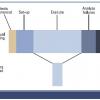|
|
The State of the Practice While software testing focuses on detection rather than prevention, we can argue that it has become a powerful counter-offensive against bugs. We can equally argue that many of today's software practices impede quality. Ross Collard compares these two positions and invites you to join the discussion.
|
|
|
|
Scrumdamentalism It's been said that, over time, charismatic movements often evolve to become "bureaucratic"—focused on a set of standardized procedures that dictate the execution of the processes within the movement. Has Scrum evolved to this point or is there still a place for agility in our processes?
|
|
 |
Software Longevity Testing: Planning for the Long Haul How long do you let your software run during testing? An increasing number of software applications are intended to run indefinitely, in an always-on operating environment. And yet, few test plans include more than a brief memory leak test case. Learn how to test for problems due to the passing of time and problems due to cumulative usage.
|
|
|
|
Food for Thought Ideas about testing can come from many different and unexpected sources, including reductionism, agronomy, cognitive psychology, mycology, and general systems. Michael feasts on Michael Pollan's "The Omnivore's Dilemma" and finds much to whet the tester's appetite for learning about how things work.
|
|
|
|
Adapting Inspections to the Twenty-first Century How do you adapt inspections to a twenty-first century distributed workforce? A key part of the inspection process is the team meeting, which provides peer pressure to participate and consensus on defects. Teams working in multiple time zones have limited opportunities for the team meeting. A list of requirements and the functions needed to solve this problem based on real-world experiences should help anyone faced with this problem.
|
|
 |
That's No Reason to Automate! Automating test execution is supposed to give tremendous benefits, but often gives disappointing results—because it hasn’t met the objectives set for it. The fault may not lie with the automation itself, but with the objectives you are attempting to achieve. Aiming at the wrong target does not bring success! For example, objectives for automation are often confused with objectives for testing, but they should be different. In this article, learn how to avoid the most insidious traps and how to recognize good objectives for automation.
|
|
|
|
Software to Go: Developing Applications for a Wireless World The mobile arena is in constant evolution, changing the way we approach software development both from a business and a technical perspective. Taking the time to set your plan can make the difference between success and just a good idea. In this article, Luis Carvalho shares some guidelines for bringing new applications into the mobile ecosystem.
|
|
 |
Testing the Contract Metaphor A contract represents a service agreement between two parties, the bounded provision of service by one party to the other. This metaphor also applies to how we can think about the relationship between unit tests and code. A contractual mindset encourages test names and partitioning based on clear propositions, backed up with executable examples.
|
|
 |
Crash Course in Proficient Presenting Ben has to make a presentation at the next all-hands meeting. It'll be his very first presentation, and just thinking about it has sent him into a panic. Fortunately, he has the support of an experienced speaker and coach who offers advice and encouragement to help him become a proficient, panic-free presenter.
|
|
 |
GUT Instinct Whether or not a unit test is considered good is not simply about what it tests: It is also very much about "how" it tests. Is the test readable and maintainable? Does it define the expected behavior or merely assume it? To be sustainable, the style of a unit test is just as important as the style of any other code. Perhaps a little surprisingly, the most commonly favored test partitioning style does not meet these expectations.
|
|

